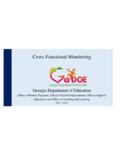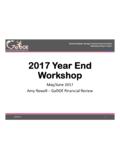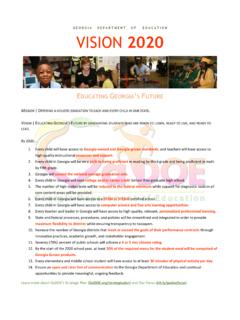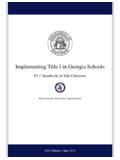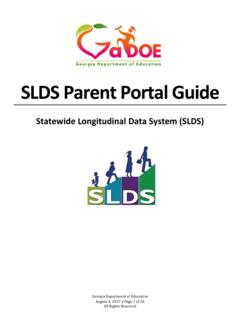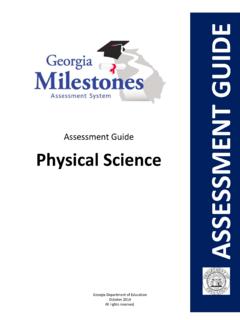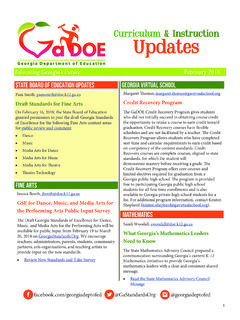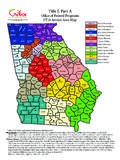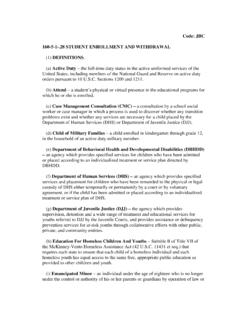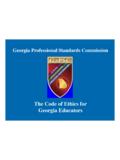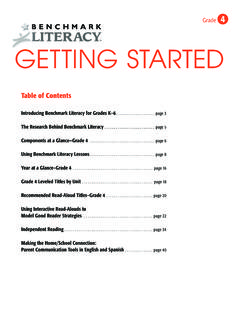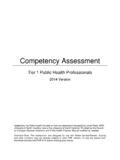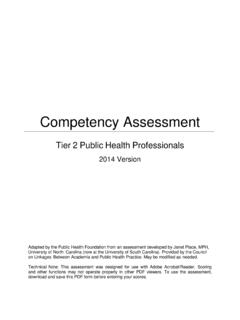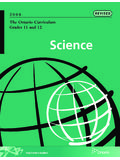Transcription of Architecture and Construction Career Cluster Architectural ...
1 georgia department of education Architecture and Construction Career Cluster Architectural Drawing and Design II. Course Number Course Description: Architectural Drawing and Design II is the third course in the Architectural Drawing and Design pathway and builds on the skills developed in Architectural Drawing and Design I. Emphasis is placed on the design process, site plans, electrical plans, plumbing plans, sections and details, project presentations, and a course portfolio. The standards are aligned with the drafting and design standards in georgia 's technical colleges, thus helping students qualify for advanced placement should they continue their education at the postsecondary level.
2 Students who successfully complete this and other drafting courses should be prepared to take an End of Pathway Assessment. Competencies for the co- curricular student organization, SkillsUSA, are integral components of both the core employability skills standards and the technical skills standards. The prerequisite for this course is Introduction to Drafting and Design and Architectural Drawing and Design I. Course Standard 1. AC-ADDII-1. The following standard is included in all CTAE courses adopted for the Career Cluster /Pathways. Teachers should incorporate the elements of this standard into lesson plans during the course.
3 The topics listed for each element of the standard may be addressed in differentiated instruction matching the content of each course. These elements may also be addressed with specific lessons from a variety of resources. This content is not to be treated as a unit or separate body of knowledge but rather integrated into class activities as applications of the concept. Standard: Demonstrate employability skills required by business and industry. The following elements should be integrated throughout the content of this course. Communicate effectively through writing, speaking, listening, reading, and interpersonal abilities.
4 Person-to-Person Telephone and Cell Phone and Communicating At Listening Etiquette Email Etiquette Internet Etiquette Work Interacting with Telephone Using Blogs Improving Reasons, Benefits, Your Boss Conversations Communication Skills and Barriers Interacting with Barriers to Phone Using Social Media Effective Oral Listening Strategies Subordinates conversations Communication Interacting with Making and Effective Written Ways We Filter Co-workers Returning Calls Communication What We Hear Interacting with Making Cold Calls Effective Nonverbal Developing a Suppliers Skills Listening Attitude Handling Conference Effective Word Use Show You Are Calls Listening Handling Unsolicited Giving and Receiving Asking Questions Calls Feedback Obtaining Feedback
5 Getting Others to Listen georgia department of education October 11, 2013 Page 1 of 5. All Rights Reserved georgia department of education Nonverbal Written Speaking Applications and Effective Communication Communication R sum s Communicating Writing Documents Using Language Completing a Job Application Nonverbally Carefully Reading Body Language Constructive One-on-One Writing a Cover Letter and mixed Messages Criticism in Writing Conversations Matching Verbal and Small Group Things to Include in a R sum . Nonverbal communication Communication Improving Nonverbal Large Group Selling Yourself in a R sum.
6 Indicators Communication Nonverbal Feedback Making Speeches Terms to Use in a R sum . Showing Confidence Involving the Describing Your Job Strengths Nonverbally Audience Showing Assertiveness Answering Questions Organizing Your R sum . Visual and Media Aids Writing an Electronic R sum . Errors in Presentation Dressing Up Your R sum . Demonstrate creativity by asking challenging questions and applying innovative procedures and methods. Teamwork and Problem Solving Meeting Etiquette Thinking Creatively Preparation and Participation in Meetings Taking Risks Conducting Two-Person or Large Group Meetings Building Team Communication Inviting and Introducing Speakers Facilitating Discussions and Closing Preparing Visual Aids Virtual Meetings Exhibit critical thinking and problem solving skills to locate, analyze and apply information in Career planning and employment situations.
7 Problem Customer Service The Application Process Interviewing Skills Finding the Solving Right Job Transferable Gaining Trust and Providing Information, Preparing for an Locating Jobs and Job Skills Interacting with Accuracy and Double Interview Networking Customers Checking Becoming a Learning and Giving Online Application Questions to Ask in Job Shopping Problem Solver Customers What Process an Interview Online They Want Identifying a Keeping Customers Following Up After Things to Include in a Job Search Problem Coming Back Submitting an Application Career Portfolio Websites Becoming a Seeing the Effective R sum s.
8 Traits Employers are Participation in Critical Thinker Customer's Point Seeking Job Fairs Managing Selling Yourself and Matching Your Talents to Considerations Searching the the Company a Job Before Taking a Job Classified Ads Handling Customer When a R sum Should be Using Complaints Used Employment Agencies Strategies for Landing an Customer Service Internship Staying Motivated to Search georgia department of education October 11, 2013 Page 2 of 5. All Rights Reserved georgia department of education Model work readiness traits required for success in the workplace including integrity, honesty, accountability, punctuality, time management, and respect for diversity.
9 Workplace Ethics Personal Employer Business Etiquette Communicating at Characteristics Expectations Work Demonstrating Good Demonstrating a Behaviors Language and Handling Anger Work Ethic Good Attitude Employers Expect Behavior Behaving Gaining and Objectionable Keeping Information Dealing with Appropriately Showing Respect Behaviors Confidential Difficult Coworkers Maintaining Honesty Demonstrating Establishing Avoiding Gossip Dealing with a Responsibility Credibility Difficult Boss Playing Fair Showing Demonstrating Your Appropriate Work Dealing with Dependability Skills Email Difficult Customers Using Ethical Being Courteous Building Work Cell Phone Etiquette Dealing with Conflict Language Relationships Showing Gaining Appropriate Work Responsibility Coworkers' Trust Texting Reducing Harassment Persevering Understanding Copyright Respecting Diversity Handling Criticism Social Networking Making Truthfulness Showing a Habit Professionalism Leaving a Job Ethically Apply the appropriate skill sets to be productive in a changing, technological, diverse workplace to be able to work independently and apply team work skills.
10 Expected Work Traits Teamwork Time Management Demonstrating Responsibility Teamwork Skills Managing Time Dealing with Information Overload Reasons Companies Use Teams Putting First Things First Transferable Job Skills Decisions Teams Make Juggling Many Priorities Managing Change Team Responsibilities Overcoming Procrastination Adopting a New Technology Problems That Affect Teams Organizing Workspace and Tasks Expressing Yourself on a Team Staying Organized Giving and Receiving Constructive Finding More Time Criticism Managing Projects Prioritizing Personal and Work Life Present a professional image through appearance, behavior and language.
